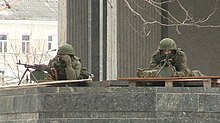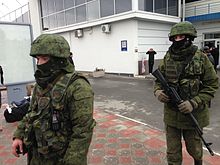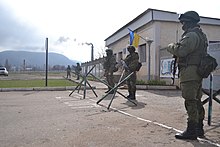
The Armed Forces of the Russian Federation, commonly referred to as the Russian Armed Forces, are the military of Russia. It is organized into three service branches—the Ground Forces, Navy, and Aerospace Forces—two independent combat arms, and the Special Operations Forces Command.

The Russian Airborne Forces is the airborne forces branch of the Russian Armed Forces. It was formed in 1992 from units of the Soviet Airborne Forces that came under Russian control following the dissolution of the Soviet Union.

The Armed Forces of South Ossetia is the military of the partially recognised state of South Ossetia. It includes an Army and an Air Corps.

The ongoing Russo-Ukrainian War began in February 2014. Following Ukraine's Revolution of Dignity, Russia occupied and annexed Crimea from Ukraine and supported pro-Russian separatists fighting the Ukrainian military in the Donbas War. These first eight years of conflict also included naval incidents and cyberwarfare. In February 2022, Russia launched a full-scale invasion of Ukraine and began occupying more of the country, starting the biggest conflict in Europe since World War II. The war has resulted in a refugee crisis and tens of thousands of deaths.

From the end of February 2014, in the aftermath of the Euromaidan and the Revolution of Dignity, which resulted in the ousting of Russian-leaning Ukrainian President Viktor Yanukovych, demonstrations by Russian-backed, pro-Russian, and anti-government groups took place in Crimea, Donetsk, Luhansk, Kharkiv and Odesa. The unrest, which was supported by the Russian military and intelligence services, belongs to the early stages of the Russo-Ukrainian War.
The annexation of Crimea by the Russian Federation took place in the aftermath of the 2014 Ukrainian revolution. On 22–23 February, Russian President Vladimir Putin convened an all-night meeting with security services chiefs to discuss pullout of deposed President, Viktor Yanukovych, and at the end of that meeting Putin remarked that "we must start working on returning Crimea to Russia.". Russia sent in soldiers on February 27, 2014. Crimea held a referendum. According to official Russian and Crimean sources 95% voted to reunite with Russia. The legitimacy of the referendum has been questioned by the international community on both legal and procedural grounds.

The Autonomous Republic of Crimea is an administrative division of Ukraine encompassing most of Crimea that was unilaterally annexed by Russia in 2014. The Autonomous Republic of Crimea occupies most of the peninsula, while the City of Sevastopol occupies the rest.

The Declaration of Independence of the Autonomous Republic of Crimea and Sevastopol was a joint resolution adopted on March 11, 2014 by the Supreme Council of Crimea and the Sevastopol City Council that proclaimed the Autonomous Republic of Crimea and the city of Sevastopol a sovereign state — the Republic of Crimea. The decision was taken after unmarked Russian soldiers invaded Ukraine and seized the Crimean parliament.

In February and March 2014, Russia invaded the Crimean Peninsula, part of Ukraine, and then annexed it. This took place in the relative power vacuum immediately following the Revolution of Dignity. It marked the beginning of the Russo-Ukrainian War.
On 18 March 2014, a Ukrainian soldier and a Russian Cossack paramilitary were killed in the first case of bloodshed during the Russo-Ukrainian War and the annexation of Crimea by the Russian Federation.

Igor Vsevolodovich Girkin, also known by the alias Igor Ivanovich Strelkov, is a Russian army veteran and former Federal Security Service (FSB) officer who played a key role in the Russian annexation of Crimea, and then in the Donbas War as an organizer of militant groups in the Donetsk People's Republic (DPR). In 2024 he was convicted on charges of inciting extremism. Earlier he received the life sentence in absentia in the Netherlands for his role in downing the Malaysia Airlines Flight 17.

The war in Donbas, also known as the Donbas war, was a phase of the Russo-Ukrainian War in the Donbas region of Ukraine. The war began in April 2014, when a commando unit headed by Russian citizen Igor Girkin seized Sloviansk in Donetsk oblast. The Ukrainian military launched an operation against them. The war continued until subsumed by the Russian invasion of Ukraine in 2022.

The 2nd Battalion of Special Assignment "Donbas" is a unit of the National Guard of Ukraine under to the Ministry of Internal Affairs of Ukraine and formerly based in Severodonetsk. Originally created in 2014 as a volunteer unit called the Donbas Battalion by Semen Semenchenko following the Russian occupation of Crimea and possible invasion of continental Ukraine. The unit first formed in the spring of 2014 during the 2014 pro-Russian unrest in Ukraine. The unit was initially formed as an independent force, but has been since fully integrated into the National Guard as the 2nd Special Purpose Battalion "Donbas" within the 15th Regiment of the National Guard.

The Wagner Group, officially known as PMC Wagner, is a Russian state-funded private military company (PMC) controlled until 2023 by Yevgeny Prigozhin, a former close ally of Russia's president Vladimir Putin. The Wagner Group has used infrastructure of the Russian Armed Forces. Evidence suggests that Wagner has been used as a proxy by the Russian government, allowing it to have plausible deniability for military operations abroad, and hiding the true casualties of Russia's foreign interventions.
The combatants of the war in Donbas included foreign and domestic forces.

The military history of the Russian Federation began with the establishment of the Russian Armed Forces following the dissolution of the Soviet Union. This was followed by its engagements in post-Soviet conflicts, from the ongoing war in Transnistria that started in 1990, after which many reforms were put in place during the late 1990s and the 2000s. Recently, the Russian military invaded Georgia in 2008 and Ukraine in 2014 and 2022, and intervened in the Syrian Civil War in 2015.
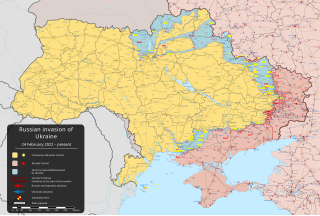
On 24 February 2022, Russia invaded Ukraine in a major escalation of the Russo-Ukrainian War, which started in 2014. The invasion, the largest conflict in Europe since World War II, has caused hundreds of thousands of military casualties and tens of thousands of Ukrainian civilian casualties. As of 2024, Russian troops occupy about 20% of Ukraine. From a population of 41 million, about 8 million Ukrainians had been internally displaced and more than 8.2 million had fled the country by April 2023, creating Europe's largest refugee crisis since World War II.
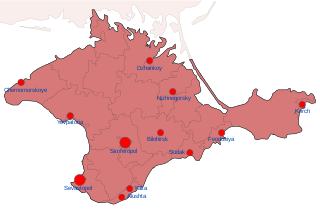
On 27 February 2014, unmarked Russian soldiers were deployed to the Crimean Peninsula in order to wrest control of it from Ukraine, starting the Russo-Ukrainian War. This military occupation, which the Ukrainian government considers to have begun on 20 February, laid the foundation for the Russian annexation of Crimea on 18 March 2014. Under Russia, the Ukrainian Autonomous Republic of Crimea was replaced by the Republic of Crimea, though the legitimacy of the latter is scarcely recognized internationally.
